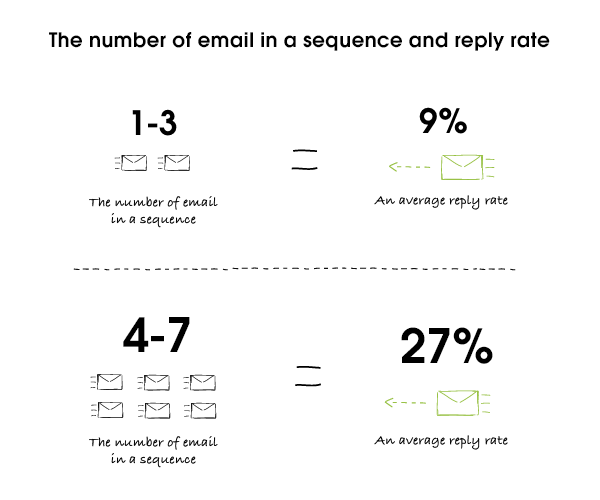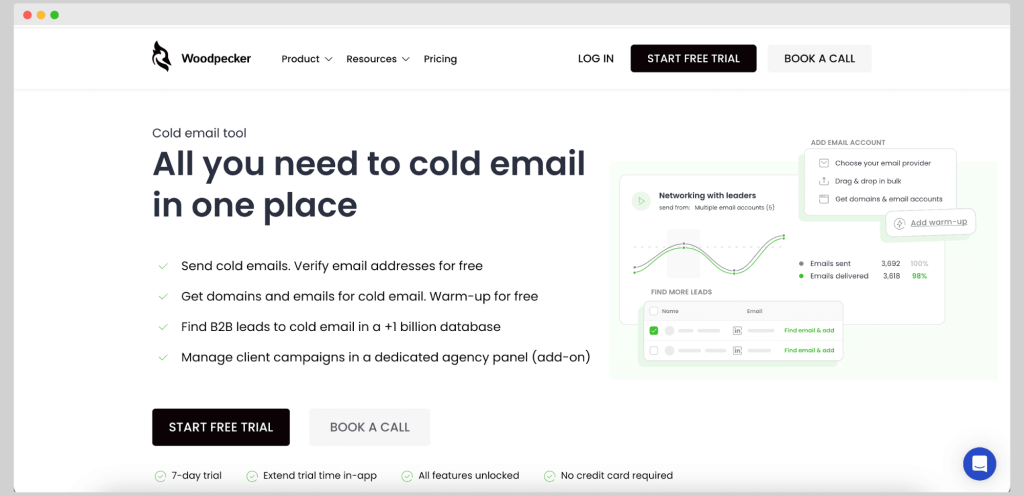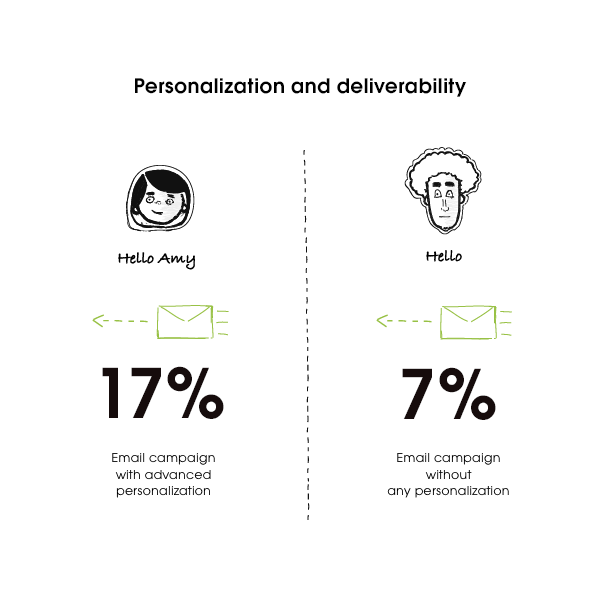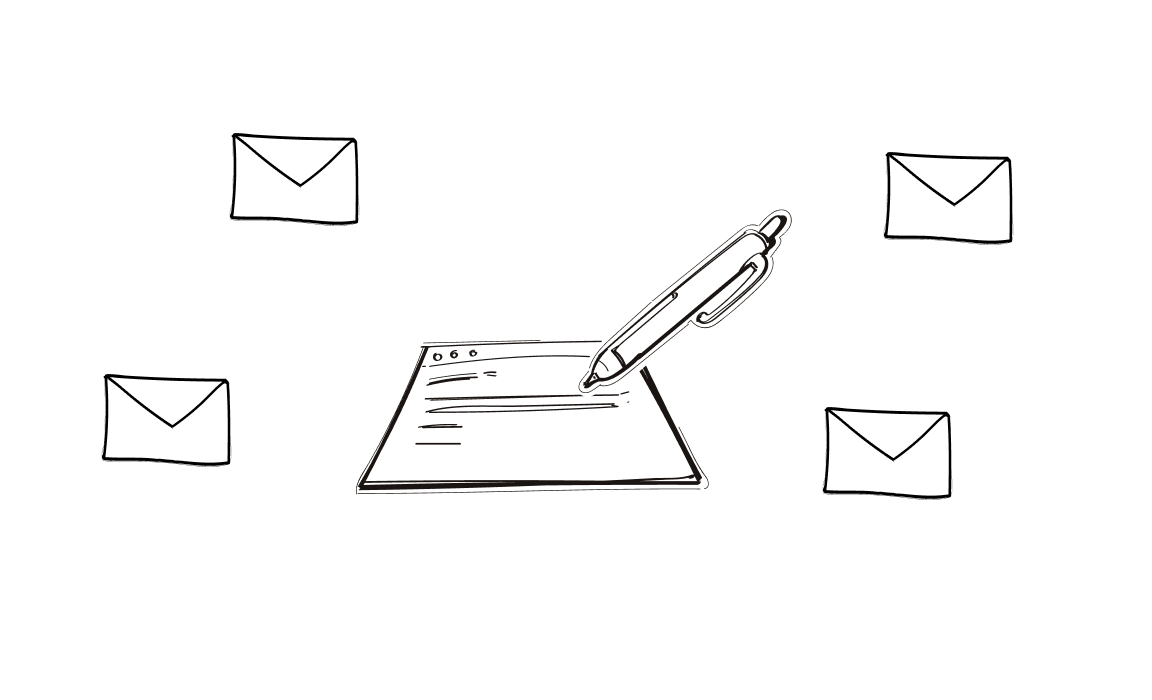Cold emails get a bad rap. But the truth is, they still work.
Want to know what doesn’t work? Sending one email and expecting magic.
If you’ve ever hit send and heard nothing back, this guide’s for you.
We’re looking into the follow-up, also known as the part most sales professionals don’t spend enough time on. And yet, it’s where most of the replies happen.
Let’s break down the follow-up strategies that are working in 2025, backed by data and filled with examples you can copy and tweak:
Why do follow-ups matter in cold emails?
You’ve crafted your perfect cold email. Hit send. Waited. Crickets.
Before you call it a lost lead, here’s the truth: most prospects don’t respond to your initial email. Not because they’re not interested, but because they’re busy or just didn’t see it.
So, how many follow-ups should you actually send?
According to our data (and we analyzed over 20 million cold emails), campaigns with 4–7 follow-ups get three times more replies than those with only 1–3 emails. That’s a 27% reply rate vs. just 9% when you don’t follow up enough.
Let that sink in: your first follow-up might be doing more heavy lifting than your original message.
That’s not all:
- Most replies come after the second or third message, not the first.
- Campaigns with more personalized subject lines and varied follow-up timing see better open and response rates.
- Keeping your follow up schedule irregular (instead of every 2 days at noon) helps you avoid looking like a robot.
The takeaway? Your follow-up strategy is where deals are made. If you’re sending one cold email and giving up, you’re likely missing out on warm leads who just needed a nudge.
Want to see how to follow up without annoying your prospects? That’s what the rest of this guide is for.
But first… cold email base examples
To make our tips easier to understand, we’ve created two simple cold email templates. We’ll use these same examples throughout the article to show how each follow-up tip works.
One email is for a software company helping creative agencies, and the other is for a logistics platform helping manufacturers.
This way, you can see how to apply the tips in real situations.
#1 Cold email A
Industry: Marketing/Creative Agencies
Product: CRM software
Subject: Helping your team spend less time chasing, more time closing
Hi [First Name],
Noticed you’re running a lean agency team which usually means juggling client work and follow-ups in the same breath.
[Company Name] helps creative agencies like yours keep track of every lead, project touchpoint and client update in one place (minus the admin overload). No bloated features, just what you need to stay organized and move faster.
If you’re still managing client relationships via spreadsheets or disconnected tools, this could be a big time-saver.
Open to a 15-minute chat next week to see if it fits?
Best,
[Your Name]
#2 Cold email B
Industry: Logistics/Operations
Product: Freight booking and tracking platform for manufacturers
Subject: Reduce freight booking errors (and emails) by 40%
Hi [First Name],
Reaching out because I saw your team handles freight ops in-house, which often means lots of emails, follow-ups and time wasted chasing ETAs.
Our platform automates freight booking, lets you track loads in real time, and reduces back-and-forth with carriers. It’s built for manufacturers still relying on email chains and spreadsheets for scheduling.
If streamlining logistics is on your radar this quarter, I’d be happy to show you how it works.
Want me to send over a short demo?
Thanks,
[Your Name]
Tried and proven cold email follow-up techniques to use in 2025
Try these tactics during your next cold email campaign and see how beneficial they can be:
#1 Send 4-7 cold follow up emails
Let’s get this out of the way: one follow-up email is rarely enough.
In fact, most replies don’t come from the initial cold email. They show up after the second, third or even seventh touch.

Surprised? Don’t be. Your prospects are busy people. Your email likely landed between a budget request and a Slack notification.
That’s why a consistent follow-up schedule matters. We’re talking 4 to 7 emails spaced over a few weeks. Not daily spamming – just thoughtful nudges that meet your target audience where they are, not where you wish they were.
Think of your follow-up sequence like a slow drip, not a fire hose. Each email is a chance to surface a different pain point or remind them you’re still here.
Curious what that looks like in action? Check out how these two base emails evolve across multiple touchpoints:
Example A (agency CRM follow-up)
Subject: Just checking, worth a look?
Hi [First Name],
Just circling back in case this got buried.
We have helped small agency teams cut admin time by up to 40%, especially when they’re managing multiple client threads and pitches.
Still happy to share a quick demo if it’s useful. Want to pick a time?
Best,
[Your Name]
Example B (freight logistics platform follow-up)
Subject: Still managing freight by email?
Hi [First Name],
Wanted to check in, totally understand if timing was off earlier.
We’ve seen manufacturers save hours each week by shifting from manual freight bookings to our platform. Less error-prone, way more scalable.
Would it help if I sent a 2-minute walkthrough?
Thanks,
[Your Name]
💡 Wondering how many follow ups to send after your initial email? Woodpecker helps sales teams send 4-7 follow-ups automatically, from your first follow up to your last. You can personalize subject lines and adjust timing, as well as track every response. Save time and turn more initial contacts into warm prospects.
Start your free trial – no credit card needed.

#2 Give them a polite nudge (quick check-in)
Sometimes all it takes is a quick reminder.
You sent the first cold email. Nothing came back. Could be bad timing. Could be they forgot. Could be your message got buried under a pile of “just checking in” emails.
So what do you do? You follow up, but kindly. No guilt trips. No passive-aggressive “I guess you’re not interested.” Just a short, polite nudge.
A sales follow-up email like this is low pressure. It’s a gentle reminder that you’re still around, and still relevant. You’re not asking for a lot. You’re just seeing if they want to keep the conversation going.
Coming up: two real examples that show how to do this without sounding needy or robotic.
Example A (agency CRM follow-up)
Subject: Quick check-in, still exploring CRM options?
Hi [First Name],
Just checking in, not sure if you’re still on the lookout for a simpler way to manage client comms and projects.
Happy to keep this short and sweet if now’s not the right time. Or I can send over a quick walkthrough video?
All the best,
[Your Name]
Example B (freight logistics platform follow-up)
Subject: Still a priority?
Hey [First Name],
Hope your week’s going smoothly. Just following up in case streamlining freight is still on your radar.
Totally get if it’s not urgent. I can check back later if that’s easier.
Cheers,
[Your Name]
#3 Add immediate value (new info or insight)
Here’s where most sales emails go stale: they repeat the same pitch.
But you? You’re smarter than that.
Instead of rehashing your value proposition, use your second (or third) follow up to bring something new to the table. A short blog post. A stat they haven’t seen. A customer story that hits on a different pain point.
This kind of follow-up email shows you’re paying attention and thinking beyond your own product.
And no, you don’t need to write a novel. A link and one strong sentence can be enough.
Let’s look at how our base cold emails build momentum by adding fresh value in their next outreach.
Example A (agency CRM follow-up)
Subject: What smart agencies are automating
Hi [First Name],
Quick heads-up – we just published a short guide on how small agencies are automating client onboarding and follow-ups using [Company Name].
Might be worth a skim if you’re juggling multiple projects and team coordination.
Want me to send it over?
Best,
[Your Name]
Example B (freight logistics platform follow-up)
Subject: 3 freight delays you can now avoid
Hi [First Name],
We just ran a benchmark across mid-size manufacturers. Turns out over 60% of shipment delays were tied to outdated booking workflows.
Our latest report breaks down how automated freight platforms are helping teams avoid those exact pitfalls.
Happy to share a copy if helpful?
Thanks,
[Your Name]
#4 Ask a question (make it easy to respond)
Want to hear back? Make it easier to say something (anything).
Instead of asking for 30 minutes or a full discovery call right away, try a simple question. One that your prospect can reply to in under 10 seconds. Are you using a CRM right now? Is freight still booked manually on your end? Want a quick walkthrough?
This works because it shifts the pressure. You’re not selling, you’re starting a chat.
Sales reps often overthink the follow-up email. But one question (the right one) can do more than a long pitch. Especially when it speaks to a prospect’s pain point.
So the next time your email thread goes quiet, don’t push – just ask.
Let’s see what that looks like with two follow-up email templates that invite a real response.
Example A (agency CRM follow-up)
Subject: Curious, are you using anything today?
Hi [First Name],
Quick one: are you currently using a CRM to manage client work, or still relying on spreadsheets?
Just helps me know if it’s worth sending you a tailored example.
Best,
[Your Name]
Example B (freight logistics platform follow-up)
Subject: Mind if I ask?
Hey [First Name],
Are you currently booking freight manually or using a platform already?
No hard sell, just want to share something relevant if there’s a fit.
Cheers,
[Your Name]
💡 Your follow-up email deserves better open rates. Woodpecker helps sales professionals send personalized subject lines and avoid the spam folder with built-in warm-up and deliverability tools.
That question in your second or third follow-up? It’s more likely to get read and answered.

#5 Break up (permission to stop)
Not every lead turns warm. And that’s OK.
But here’s the trick: your last follow-up email shouldn’t slam the door. It should leave it slightly open.
A good break-up email does two things. One, it shows respect for your prospect’s time. Two, it gives them space to come back later. It’s also a smart follow-up strategy to clean up your pipeline without burning bridges.
You’re not quitting. You’re giving them the choice to opt out or opt back in when the timing fits.
Want to see how a short goodbye can still open future doors? Keep reading for two cold email examples that end things on a high note.
Example A (agency CRM follow-up)
Subject: Should I stop reaching out?
Hi [First Name],
I haven’t heard back, so I’ll assume now’s not the right time, totally fine.
If things change or you start rethinking how you manage client relationships, happy to pick this back up.
Wishing you a smooth quarter,
[Your Name]
Example B (freight logistics platform follow-up)
Subject: Let me know if I should close this out
Hey [First Name],
No pressure, just wanted to check if this is still something you’re considering. If not, I’ll close the loop on my end.
Feel free to reach out if freight processes come back on your radar.
All the best,
[Your Name]
#6 Time follow-ups strategically
When you send your follow-up can matter as much as what it says.
Think about it: a sales email in the middle of Monday chaos? Likely ignored. But late Wednesday afternoon, when inboxes are clearer? Better shot.
Same with seasons. If your prospect’s business slows in Q4, maybe don’t hit them hard in December. Instead, time your follow-up to match their real-world pace.
This kind of follow-up strategy isn’t about luck. It’s about tracking responses and sending follow-up emails when your message stands out.
Coming up: two examples that show how smart timing can lift your open and response rates without rewriting your pitch.
Example A (agency CRM follow-up)
Subject: June tends to get hectic, worth revisiting CRM?
Hi [First Name],
Noticed it’s mid-June, often when agency teams are juggling a lot before summer holidays kick in.
If things feel a bit scattered on the client side, now could be a good time to test a lighter CRM setup. Want me to share how others are using [Company Name] to prep for a smoother Q3?
Best,
[Your Name]
Example B (freight logistics platform follow-up)
Subject: Freight delays usually spike mid-year
Hi [First Name],
Freight teams often see a spike in scheduling issues this time of year, especially with summer inventory cycles.
If reducing carrier emails and ETA guesswork is still a goal, I can show you how our customers are staying ahead of the curve.
Would next week work for a quick demo?
Thanks,
[Your Name]
#7 Personalize every follow-up to build relationships
No one wants to read an email that could have been sent to 500 other people.
That’s why personalization still wins. Not just using their name or company (not that it’s bad, just entry-level).

We’re talking real details. Something they posted. A new product launch. A campaign they just ran. Anything that shows you actually looked them up.
These little touches can turn cold leads into warm prospects.
And no, you don’t need to spend hours researching each contact. A quick scan of their site or LinkedIn can give you enough to work with.

Want to see what a personalized follow-up looks like without sounding fake? Check the examples below.
Example A (agency CRM follow-up)
Subject: Loved your team’s [client campaign/project]
Hi [First Name],
Saw the [Client X campaign] your team launched – super smart use of storytelling. I imagine keeping projects like that on track requires tight coordination.
Just wanted to say that’s exactly where [Company Name] helps agency teams cut down on scattered updates and missed follow-ups.
Still open to a look?
Cheers,
[Your Name]
Example B (freight logistics platform follow-up)
Subject: Noticed you’re expanding ops, need a hand?
Hi [First Name],
Congrats on the new facility in [location] – big move! That kind of growth usually comes with added freight volume and complexity.
If that’s on your radar, happy to share how others in your space are scaling bookings and tracking without the email clutter.
Kind regards,
[Your Name]
Check out how to get easy access to your prospects’ LinkedIn profiles and make LinkedIn outreach easier by adding LinkedIn manual tasks as steps in your campaigns here.
#8 Use different channels (optional)
Email isn’t your only option.
Sometimes, a quick LinkedIn message or even a short comment on a post can do more than a perfect sales email. Because let’s face it: inboxes are crowded. A cold email can go unread, but a well-timed DM? That gets noticed.
Now, this doesn’t mean you need to go full-on multichannel for every lead. Pick your moments. Maybe after your second follow up. Or if someone clicked but didn’t reply.
Just don’t be weird. If you’re going to switch channels, do it with context. Mention your previous message. Be brief and authentic.
💡 Managing outreach across email, CRMs and lead tools? Woodpecker lets you track replies from the initial email to the last follow up and manage multiple campaigns in one place. Perfect for sales teams working across channels to reach potential customers.

Here are some quick, real-world examples of how to switch channels in a smart, non-pushy way:
- LinkedIn DM after second follow-up:
“Hey [First Name], sent you a quick email last week re: helping your team track projects more easily. Thought I’d reach out here too in case inbox timing was off.” - Reply to a LinkedIn post:
“Loved your post on scaling without burning out. We’ve seen a lot of agencies hit that same point. Sent over an email, would love your take when you have a sec.” - Voice note (if connection already exists):
“Hey [First Name], just wanted to say I sent over a short note that might help with [pain point]. No rush, but figured this might cut through the inbox noise.” - Twitter/X or Instagram reply (if active):
“Saw your new project launch, looks great. Sent a quick email that ties in with what you’re working on. Happy to send again if you missed it.” - Cold call follow-up to email open (brief):
“Hi [First Name], I’m the one who sent that email about [short reminder of offer]. Just wanted to see if you had 2 mins this week. If not, all good!”
Cold email campaigns made easy
As you can see, cold outreach doesn’t need to feel cold.
No matter if it’s your first follow up or your eighth, each message is a chance to reconnect and remind your prospect why you reached out in the first place.
The best follow-up emails? They sound like a person, not a script. They land in the right inbox at the perfect time and with the correct question or insight.
Want help scaling that kind of outreach without losing the human touch? That’s exactly what Woodpecker was built for.
Start your 7-day trial today and make follow-ups the strongest part of your cold email strategy.

